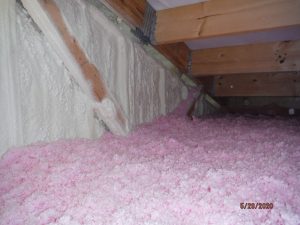Reader TIM from INVER GROVE HEIGHTS, MN has a chilling challenge, he writes:
“Fabulous site, congrats. I have a 40×60 pole barn with 10ft ceiling to the bottom of the rafters. Last year I put a 150k btu heater in to try and take the chill out a bit. It didn’t work so well because the building is not tight at all. I know I could spray foam it. Is there anything that I could do less expensive? I was told to put 6mil ply sheeting under the rafters at 10feet to seal that space and the leaks that are on the end of the building away from the space below where the heater is. Plus I would not be heating the area above anymore. I only heat it for a few hours 4-5 days a week. Thoughts?”
Possible solutions could end up making two dollars per square foot of surface (for two inch thickness) of closed cell spray foam a bargain.
If you do not have some form of condensation control between roof framing and roof steel, you are going to need to closed cell spray foam the underside of your roof steel (again two inches), otherwise it will rain inside your building.
 As heat rises, let’s begin there. Determine if your roof trusses are designed to support a ceiling load. This can be found by examining your engineered truss drawings supplied when trusses were delivered. If not available, look for the manufacturer’s stamp located on truss bottom chords. If you contact them with your site address, they should be able to pull up your building’s records. You want to find at least a five psf (pounds per square foot) ceiling (bottom chord) dead load (although three psf would support a steel liner panel ceiling). If inadequate to support a ceiling, your truss manufacturer can provide (for a nominal fee) a repair design to upgrade your trusses. Once it is determined trusses can support a load (or have been repaired in order to do so), add ceiling framing between trusses (if over two foot on center) to support drywall (my personal preference – use 5/8″ Type X) or a steel liner.
As heat rises, let’s begin there. Determine if your roof trusses are designed to support a ceiling load. This can be found by examining your engineered truss drawings supplied when trusses were delivered. If not available, look for the manufacturer’s stamp located on truss bottom chords. If you contact them with your site address, they should be able to pull up your building’s records. You want to find at least a five psf (pounds per square foot) ceiling (bottom chord) dead load (although three psf would support a steel liner panel ceiling). If inadequate to support a ceiling, your truss manufacturer can provide (for a nominal fee) a repair design to upgrade your trusses. Once it is determined trusses can support a load (or have been repaired in order to do so), add ceiling framing between trusses (if over two foot on center) to support drywall (my personal preference – use 5/8″ Type X) or a steel liner.
Blow in R-60 of fiberglass or cellulose insulation on top of your new ceiling. Make sure to not block airflow coming in from sidewall vented soffits. Should you not have a vented overhang and vented ridge cap, you will need to add gable vents located in the top half of each endwall with a minimum of 576 square inches of net free ventilation area in each endwall.
Made spray foam sound easy, didn’t I?






